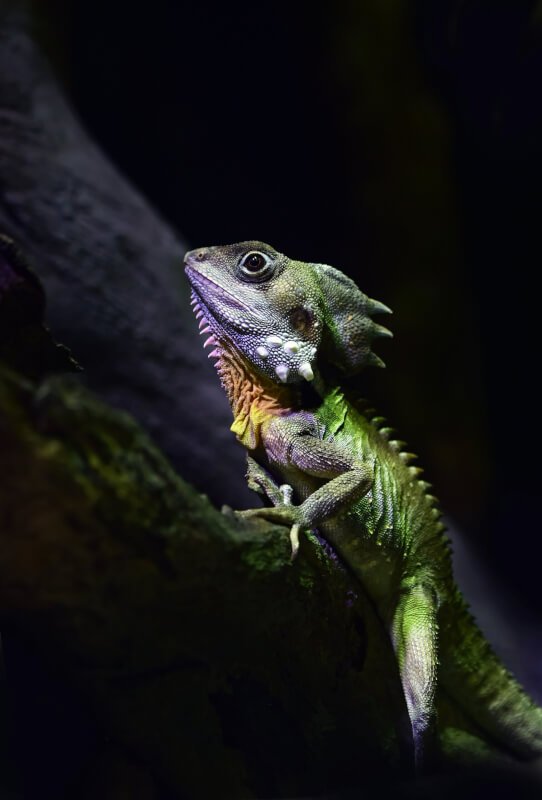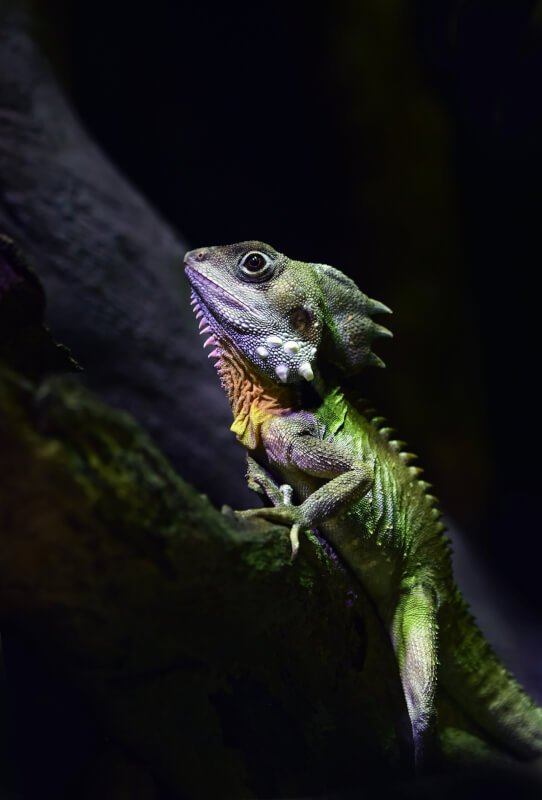When it comes to providing the ideal living space for your snake, ensuring a safe and comfortable nesting area is crucial. Creating a stress-free environment not only contributes to the overall well-being of your slithery friend but also helps them thrive. In this article, we will explore some essential tips and considerations for setting up the perfect nesting area that will make your snake feel right at home. From selecting the right enclosure to providing the necessary temperature and humidity levels, you’ll discover the key elements to create the ultimate sanctuary for your scaly companion.

Choosing the Right Enclosure
Researching Snake Species
When it comes to choosing the right enclosure for your snake, it’s important to first research the specific requirements of the snake species you’re considering. Different snake species have different needs in terms of habitat, temperature, humidity, and space. By understanding the natural habitat and behavior of the snake species, you can create an enclosure that closely mimics its natural environment, ensuring the snake feels safe and comfortable.
Considering the Snake’s Size
Another important factor to consider when selecting an enclosure is the size of your snake. Snakes come in a variety of sizes, from small corn snakes to large pythons. It’s crucial to provide an enclosure that is appropriately sized for your snake’s size and activity level. Providing enough space is essential for the snake’s physical and mental well-being, as a cramped enclosure can lead to stress, behavioral issues, and even health problems.
Determining the Type of Enclosure
There are different types of enclosures available for snakes, including glass terrariums, plastic tubs, custom-built cages, and even converted furniture. The type of enclosure you choose will depend on factors such as the size of your snake, the amount of space you have available, your budget, and your preferences. Each type of enclosure has its pros and cons, so it’s important to weigh these factors carefully before making a decision.
Evaluating Ventilation and Temperature Control
Ventilation and temperature control are crucial for maintaining a healthy and comfortable environment for your snake. Good ventilation ensures fresh air circulation and helps prevent respiratory issues, while temperature control is essential for regulating a snake’s metabolism and overall well-being. It’s important to choose an enclosure that allows for proper airflow and has provisions for heating elements, such as heat lamps or heating pads, to create the optimal temperature gradient in the enclosure.
Selecting Suitable Substrates
Selecting the right substrate for your snake’s enclosure is important for several reasons. The substrate serves as a base layer for the enclosure, providing a natural and comfortable surface for your snake to move on. It also helps maintain humidity levels and aids in maintaining the overall cleanliness of the enclosure. There are various types of substrates available, including aspen shavings, cypress mulch, reptile carpet, and paper-based products. It’s important to choose a substrate that is safe, easy to clean, and suitable for the species of snake you have.
Providing Adequate Space
Calculating the Ideal Enclosure Size
When determining the size of your snake’s enclosure, it’s important to provide adequate space for the snake to move around, stretch out, and exhibit natural behaviors. As a general rule of thumb, the enclosure should be at least as long as the snake’s length and twice as wide as the snake’s maximum width. Additionally, extra vertical space should be considered for arboreal snake species. It’s always better to provide a larger enclosure than the minimum requirements to ensure the snake’s comfort and well-being.
Including Hiding Spots
Snakes are naturally shy and secretive creatures, and providing hiding spots in their enclosure is essential to help them feel secure. Hiding spots can be as simple as half-logs, rock caves, or hollowed-out objects, allowing the snake to retreat and feel safe whenever it desires. Place hiding spots on both the warm and cool sides of the enclosure, ensuring the snake has options to regulate its body temperature comfortably and reduce stress.
Considering Vertical Space
While most snakes are primarily ground-dwelling, some species, such as tree boas or tree pythons, are arboreal and require vertical space in their enclosure. Providing height in the enclosure allows arboreal snakes to climb, perch, and utilize the vertical space for natural behaviors. Incorporating branches, climbing structures, or specially designed perches can help simulate a natural habitat and provide enrichment opportunities for arboreal snake species.
Providing a Suitable Climbing Area
Snakes, whether terrestrial or arboreal, can benefit from having climbing opportunities in their enclosure. Having climbing structures, such as branches or driftwood, allows the snake to exercise, explore its environment, and exhibit natural behaviors. Just be sure that the climbing structures are secure and stable to prevent any potential falls or injuries to the snake.
Setting the Optimal Temperature and Humidity
Understanding Temperature Requirements
Snakes are ectothermic creatures, meaning they rely on external heat sources to regulate their body temperature. It’s crucial to provide a temperature gradient within the enclosure, allowing the snake to move between different temperature zones according to its needs. The enclosure should have a warm side and a cool side, with a temperature gradient of approximately 80-85°F (26-29°C) on the warm side and 75-80°F (24-27°C) on the cool side. This temperature gradient provides the snake with options to thermoregulate and promotes healthy digestion, activity, and overall well-being.
Choosing the Right Heating Source
To create and maintain the appropriate temperature gradient in the enclosure, it’s important to choose the right heating source. Common heating options for snake enclosures include heat lamps, ceramic heat emitters, heat pads, and radiant heat panels. The specific heating source you choose will depend on factors such as the size of the enclosure, the heating requirements of your snake species, and personal preferences. Always make sure to use thermostats or temperature controllers to prevent overheating and ensure the safety of your snake.
Creating a Thermal Gradient
A thermal gradient refers to the range of temperatures available to the snake within the enclosure. To create a thermal gradient, place the heating source on one side of the enclosure, creating a warm zone, while the other side remains cooler. This setup allows the snake to move between the warm and cool zones, allowing it to regulate its body temperature based on its needs. This thermal gradient is crucial for the snake’s overall health and allows it to thermoregulate efficiently.
Maintaining Proper Humidity Levels
Humidity levels are important for certain snake species, particularly those from tropical or semi-tropical regions. Some species require higher humidity levels, while others prefer drier environments. It’s essential to research the specific humidity requirements of your snake species and provide the appropriate levels within the enclosure. This can be achieved through misting, the use of humidifiers, providing a moist hide area, or using specific substrates that retain moisture. Regular monitoring of humidity levels and adjusting as needed will help ensure your snake’s comfort and prevent any humidity-related health issues.
Lighting and Photoperiod
Types of Lighting for Snakes
While natural sunlight is the best source of light for snakes, it may not always be practical or possible to provide direct sunlight in the enclosure. In the absence of natural sunlight, artificial lighting can be used to fulfill the snake’s lighting needs. Full-spectrum UVB bulbs are a popular choice, as they provide a balanced spectrum of light that helps with vitamin D synthesis and overall well-being. Additionally, providing a light source can help establish a natural light cycle and promote healthier behaviors in your snake.
Importance of Photoperiod
A consistent photoperiod, or light cycle, is important for maintaining a healthy sleep-wake cycle and general well-being in snakes. In the wild, snakes experience natural variations in daylight throughout the year, and replicating this cycle in captivity is essential. Maintaining a consistent 12-hour light and 12-hour dark cycle can help promote natural behaviors and overall health in your snake.
Providing a Natural Light Cycle
To provide a natural light cycle for your snake, it’s important to mimic the natural daylight and darkness periods. Use a timer to ensure consistent lighting, and avoid exposing the snake to excessive light or darkness. It’s also important to place the enclosure away from direct sunlight or artificial light sources that can disrupt the snake’s natural light cycle. By providing a consistent and natural light cycle, you can help regulate your snake’s biological functions and contribute to its overall well-being.

Furnishing the Enclosure
Adding Hides and Shelter
Hides and shelters are essential for creating a sense of security and privacy for your snake. Snakes are naturally inclined to seek out hiding spots, where they can feel safe and secure. Provide at least two hide spots – one on the warm side of the enclosure and one on the cool side – to allow the snake to regulate its body temperature comfortably. Hides can be made from various materials, such as half-logs, cave-like structures, or commercially available hides designed specifically for snakes.
Selecting and Arranging Décor
Adding décor to the enclosure can enhance your snake’s environment and make it more aesthetically pleasing. When selecting décor, it’s important to choose materials that are safe for your snake and easy to clean. Avoid using materials that could be harmful if ingested, such as small rocks, sharp edges, or toxic plants. Arrange the décor in a way that provides hiding spots, climbing opportunities, and allows the snake to move and explore its environment naturally.
Including Suitable Branches or Perches
If you have an arboreal snake species, providing suitable branches or perches is important for their well-being. These climbing structures allow arboreal snakes to exercise and exhibit their natural behaviors. Choose sturdy, non-toxic branches, preferably with varied diameters, to mimic the complexity of natural tree branches. Secure the branches to ensure they are stable and provide hiding spots or additional enrichment opportunities.
Enhancing the Environment with Plants
Adding live or artificial plants to the snake’s enclosure can help create a more natural and visually appealing environment. Live plants provide additional benefits by aiding in humidity regulation, oxygen production, and providing enrichment opportunities for the snake. When choosing live plants, ensure they are non-toxic and can thrive in the enclosure conditions, or consider using artificial plants that closely resemble their live counterparts. Regular maintenance, such as pruning or replacing wilted plants, is necessary to maintain a healthy and safe environment for your snake.
Maintaining Cleanliness
Spot Cleaning on a Regular Basis
Keeping the snake’s enclosure clean is crucial for its health and well-being. Spot cleaning involves removing any waste, uneaten food, shed skin, or debris from the enclosure on a regular basis. This should be done as soon as any waste is noticed to prevent the buildup of bacteria and foul odors. Spot cleaning can be done using gloves, a scoop, or a designated spot cleaning tool, ensuring proper hygiene and preventing cross-contamination.
Deep Cleaning and Disinfecting
In addition to spot cleaning, regular deep cleaning and disinfecting of the enclosure is necessary to maintain a clean and healthy environment for your snake. Deep cleaning involves removing all the substrate, cleaning the enclosure thoroughly with a reptile-safe disinfectant, and rinsing it thoroughly. Allow the enclosure to dry completely before adding fresh substrate and returning your snake. This deep cleaning process should be performed every few months or as needed, depending on the snake’s habits and the level of cleanliness required.
Preventing and Treating Mites
Mites are common external parasites that can affect snakes and cause great discomfort. Regular monitoring and preventative measures are crucial to keep mite infestations at bay. Implementing a quarantine process for new snakes or snake items, regularly inspecting your snake for any signs of mites (such as excessive scratching or small black dots), and maintaining proper hygiene practices will help prevent mites from infesting the enclosure. If mites are detected, prompt treatment with appropriate reptile-safe products is necessary to eliminate them and prevent further spread.
Avoiding Contamination from Feeding
Feeding your snake inside its enclosure can lead to spills, leftover food, or soiled substrate, which can contaminate the environment. To avoid contamination, it’s recommended to use a separate feeding area outside the enclosure. This can be a designated feeding tub or a sectioned-off area within the enclosure. Feeding in a separate area not only prevents contamination but also helps condition the snake to associate that particular area with feeding time, reducing the risk of aggression or mistaken feeding responses within the enclosure.

Feeding Considerations
Understanding the Snake’s Diet
Snakes have diverse dietary needs, depending on their species and age. Some snakes are strictly carnivorous, while others may feed on a variety of prey items, such as rodents, birds, or fish. It’s important to research the specific dietary requirements of your snake species and provide appropriate prey items. Feeding your snake a balanced diet that meets its nutritional needs is essential for its growth, health, and overall longevity.
Choosing the Right Food Size
Selecting the right-sized prey items for your snake is important for proper digestion and preventing any potential health issues. Prey items should be approximately the same size or slightly larger than the widest part of the snake’s body. Feeding prey that is too large can lead to regurgitation or digestive problems, while prey that is too small may not provide the necessary nutritional value. Always monitor your snake during feeding to ensure it swallows the prey item properly.
Establishing a Feeding Schedule
Establishing a regular feeding schedule is important for maintaining your snake’s health and preventing overfeeding or food aggression. The frequency of feedings will depend on the age, size, and species of your snake, as well as its individual metabolism. Consult with a reptile veterinarian or reputable sources to determine an appropriate feeding schedule for your snake. Younger snakes may require more frequent feedings, while adult snakes often eat less frequently.
Providing a Dedicated Feeding Area
As mentioned earlier, feeding your snake in a designated area outside of its enclosure is recommended to prevent contamination and maintain cleanliness. When setting up a feeding area, ensure it is easily accessible and separate from the snake’s living space. Use feeding tongs to offer the prey item to the snake to reduce the risk of accidental bites or aggression. After feeding, clean the feeding area thoroughly to prevent the buildup of bacteria or odors.
Handling and Enrichment
Understanding Proper Handling Techniques
Proper handling techniques are essential for both the safety of the snake and the handler. Snakes are sensitive to touch and may become stressed or defensive if handled incorrectly. Always approach the snake calmly and confidently, supporting its body and avoiding any sudden movements. Avoid handling your snake directly after a feeding, during shedding, or when it appears agitated or defensive. If unsure about handling techniques, seek guidance from a reptile expert or veterinarian to ensure the safety and well-being of both you and your snake.
Avoiding Stress or Aggression
Snakes are generally solitary and prefer to be left undisturbed in their enclosures. Handling should be kept to a minimum and done with care to avoid causing unnecessary stress or aggression. Pay attention to the snake’s body language and behavior, such as hissing, defensive postures, or attempting to bite. If your snake exhibits signs of stress or aggression, it’s best to let it rest and provide it with a secure and quiet environment.
Providing Mental Stimulation
Enrichment activities are important for promoting mental stimulation and preventing boredom in captive snakes. In the wild, snakes engage in various behaviors, such as exploring, hunting, and climbing. You can replicate these activities in the enclosure by providing environmental enrichment, such as hiding food or scenting objects to encourage the snake’s hunting instincts. Additionally, rotating or rearranging the décor periodically can help stimulate the snake’s curiosity and provide a more engaging environment.
Offering Enrichment Activities
In addition to environmental enrichment, offering specific activities can provide additional mental stimulation for your snake. This can include introducing puzzle feeders, which require the snake to problem-solve and manipulate objects to access their food. You can also provide a snake-safe mirror to allow the snake to interact with its reflection. Remember to observe your snake during enrichment activities to ensure they are not becoming stressed or overwhelmed.

Monitoring Health and Behavior
Regular Health Checks
Regular health checks are essential for monitoring your snake’s overall health and well-being. Observation is key when it comes to detecting any changes in behavior, appetite, or appearance, which could be indicators of potential health issues. Regularly check your snake’s skin, eyes, oral cavity, and vent area for any abnormalities or signs of injury or illness. Take note of any changes in weight, shedding patterns, or overall activity level. If any concerns arise, consult with a reptile veterinarian for a professional assessment and guidance.
Observing Feeding and Digestion
Observing your snake during feeding and digestion is another important aspect of monitoring its health. Ensure that your snake is eating regularly and showing a healthy appetite. Monitor the digestion process by observing the snake’s bowel movements and the shedding of its skin. Any sudden changes in eating habits, weight loss, regurgitation, or difficulties shedding should be noted and investigated promptly. Digestive issues can be an indication of underlying health problems and require attention from a veterinarian.
Recognizing Signs of Illness
Snakes are known for their ability to hide signs of illness, so it’s important to be vigilant and recognize subtle changes in their behavior or appearance. Signs of illness may include lethargy, loss of appetite, weight loss, abnormal feces, respiratory issues, visible lesions, or abnormal shedding. If you notice any of these signs or have concerns about your snake’s health, it’s crucial to seek veterinary care as soon as possible. Early intervention and proper diagnosis are key to successful treatment and recovery.
Seeking Veterinary Care
Regular veterinary care is essential for maintaining the health and well-being of your snake. Seek out a reptile-experienced veterinarian for routine check-ups, vaccinations (if applicable), and any necessary medical care. A reptile veterinarian can provide guidance on proper husbandry, diet, parasite prevention, and can diagnose and treat any health issues that may arise. Establishing a relationship with a reptile veterinarian ensures that your snake receives the necessary care and attention it needs to stay happy and healthy.
Conclusion
Keeping your snake happy and healthy requires careful consideration of its enclosure, space requirements, temperature, lighting, furnishings, cleanliness, feeding, handling, and overall well-being. By following the guidelines outlined in this comprehensive article, you can provide a safe and comfortable nesting area for your snake. Remember to continuously monitor your snake’s health and behavior, seeking veterinary care when necessary, and always adapting the enclosure as needed to meet the changing needs of your snake. With proper care and attention, you can ensure your snake thrives in its home and maintains a high quality of life.



